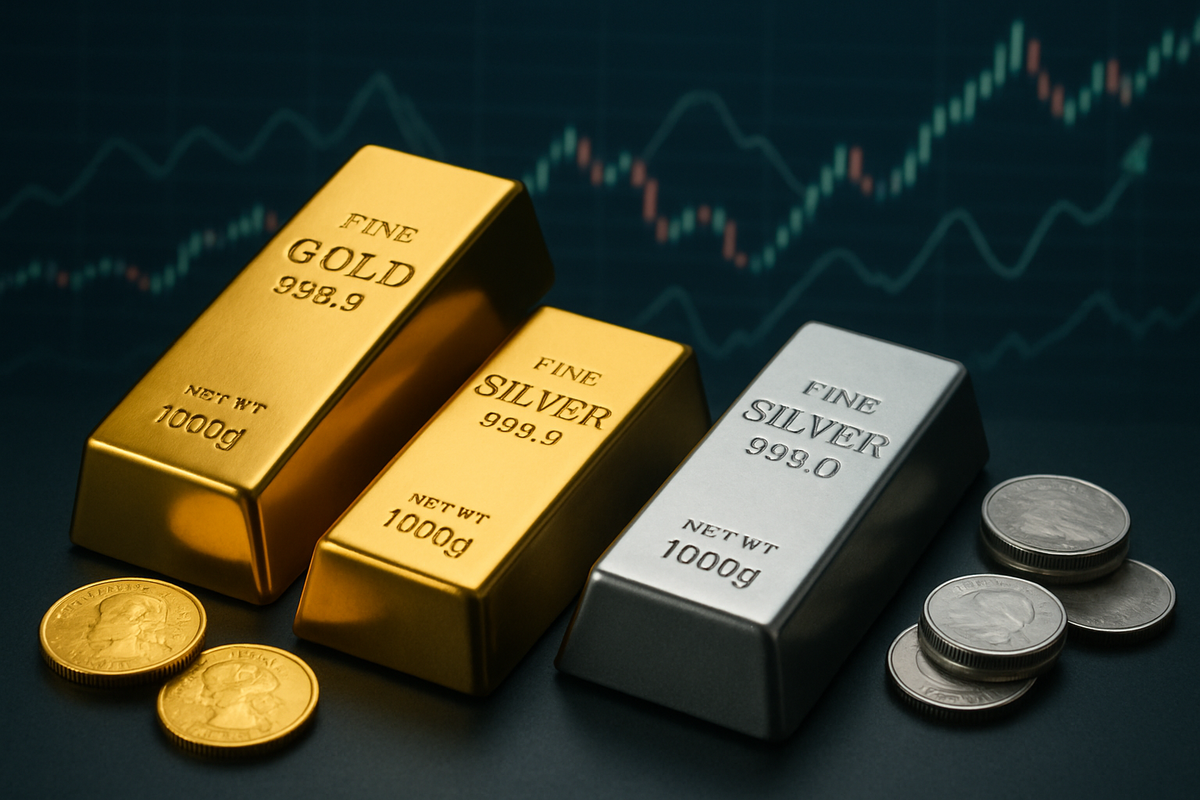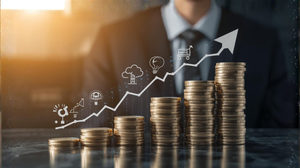Financial News
Gold and Silver Stage Intraday Rebound: A 'Buy the Dip' Opportunity Amidst Market Volatility?

In a significant turn of events, gold and silver markets are witnessing a notable intraday rebound as of October 23, 2025, signaling a potential stabilization after a period of sharp corrections. This upward movement has ignited discussions among investors about whether the recent dip presents a strategic 'buy' opportunity, particularly as global economic indicators and geopolitical tensions continue to shape market sentiment. The precious metals, often considered safe-haven assets, are navigating a complex landscape of anticipated Federal Reserve interest rate cuts, persistent inflation concerns, and shifting trade dynamics.
The immediate implications of this rebound are multifaceted. While short-term volatility is expected to persist, many analysts are cautiously optimistic, suggesting that the recent sell-off might have been a healthy correction within a broader bullish trend. Investors are now keenly observing whether this recovery can sustain momentum, potentially ushering in a new phase of growth for gold and silver, or if it merely represents a temporary reprieve before further price discovery. The coming weeks will be crucial in determining the metals' trajectory and validating the 'buy the dip' thesis.
Precious Metals Roar Back: A Detailed Look at the Recent Market Dynamics
The current intraday rise in gold and silver marks a pivotal moment following a period of intense volatility. Just days prior to October 23, 2025, both metals experienced a significant "sell-off" that saw prices plummet from their recent historic highs. Gold, which had soared past $4,000 per ounce to an all-time nominal high of approximately $4,379.96 on October 16, 2025, suffered its largest single-day percentage decline in over a decade, dropping as much as 6.3%. Silver followed a similar trajectory, falling up to 8.7% after touching highs above $50 per ounce by October 13, 2025. This sharp correction was largely attributed to profit-taking by investors and technical indicators suggesting an "overbought" market.
However, October 23, 2025, brought a discernible shift in sentiment. Gold futures for December delivery on the Multi Commodity Exchange (MCX) increased by 1.48%, while silver futures rose by 1.87%. Globally, Comex gold futures added 1.81%. This recovery is being interpreted as a result of "value buying" and bargain hunting, as traders perceived an easing of the risk-off mood that had previously gripped the markets. A key driver behind the earlier rally, and now a supportive factor for the rebound, has been the strong expectation of aggressive interest rate cuts by the US Federal Reserve throughout 2025. Futures markets on October 23 were pricing in a 97% probability of a 25-basis-point rate cut at the Fed's upcoming October 29 meeting, with another likely in December. Lower interest rates reduce the opportunity cost of holding non-yielding assets like gold and silver, making them more attractive.
Beyond monetary policy expectations, persistent global inflationary pressures continue to fuel demand for precious metals as a hedge against currency debasement. Conversely, a strengthening US dollar had previously made gold and silver more expensive for international buyers, contributing to the recent price drops. Central banks, particularly in emerging markets such as China, India, and Turkey, have also been significant players, accumulating gold at an unprecedented rate to diversify away from the dollar, providing a structural floor for prices. Furthermore, silver's dual role as both a precious and an industrial metal—critical for rapidly expanding sectors like solar panels, electric vehicles, and semiconductors—has led to record-level demand forecasts for 2025, creating a supply-demand imbalance that strongly supports its price. The interplay of these factors, from technical corrections to fundamental demand, has shaped the recent volatile yet ultimately rebounding market for gold and silver.
Companies Navigating the Precious Metal Tides: Winners and Losers in a Volatile Market
The recent gyrations in gold and silver prices, from their historic highs to a sharp correction and subsequent intraday rebound, are creating distinct winners and losers across the precious metals industry. Companies directly involved in mining, streaming, and refining are acutely sensitive to these price movements, impacting their stock performance, profitability, and strategic decisions.
Gold and silver mining companies, due to their operational leverage, tend to experience amplified reactions to commodity price changes. When prices surged earlier in 2025, companies like Newmont Corporation (NYSE: NEM), the world's largest gold producer, and Barrick Gold Corporation (NYSE: GOLD), a leading global gold and copper producer, saw significant boosts to their revenues and profit margins. Similarly, major silver miners such as Pan American Silver Corp. (NASDAQ: PAAS) and First Majestic Silver Corp. (NYSE: AG) capitalized on the robust demand. However, the recent correction, even if short-lived, can lead to sharp declines in their stock values, as seen with some miners experiencing double-digit percentage drops. Despite the volatility, the current gold prices, which remain well above the "all-in sustaining costs" (AISC) of most producers (typically $1,100 to $1,400 per ounce), still provide substantial profit margins, allowing companies like Agnico Eagle Mines Limited (NYSE: AEM) and Kinross Gold Corporation (NYSE: KGC) to maintain healthy financials. In response to price swings, these miners often adjust capital expenditure, focusing on cost control and operational efficiency to preserve margins.
Precious metals streaming and royalty companies, such as Wheaton Precious Metals Corp. (NYSE: WPM) and Franco-Nevada Corporation (NYSE: FNV), typically exhibit more stable revenue streams. These companies provide upfront financing to miners in exchange for the right to purchase a percentage of future production at a fixed, low price. They benefit significantly from rising spot prices because the spread between their fixed purchase price and the higher market selling price widens, boosting their margins without direct exposure to mining's operational risks. While their stock performance is positively correlated with precious metal prices, they often experience less volatility than direct miners during price swings, making them potentially more resilient during corrections.
Companies in the refining and related industries, including Rajesh Exports Ltd. (NSE: RAJESHEXPO), a global leader in gold refining, and A-Mark Precious Metals, Inc. (NASDAQ: AMRK), a full-service precious metals dealer and refiner, face a different set of challenges and opportunities. While high and stable precious metal prices generally lead to increased inventory value and sales, extreme volatility, like the recent rapid ascent and correction, can introduce inventory valuation risks and make hedging strategies more complex. For refiners, consistent demand and stable, elevated prices are ideal for sustained profitability. For jewelry manufacturers, high precious metal prices can increase revenue but also impact consumer demand, requiring careful inventory and pricing management. Ultimately, the ability of these companies to adapt their operational strategies, manage costs, and effectively hedge against price fluctuations will determine their success in this dynamic market.
Broader Implications: A Barometer of Global Economic and Geopolitical Currents
The intraday rise of gold and silver on October 23, 2025, extends beyond mere price fluctuations, serving as a significant barometer of broader industry trends and global economic and geopolitical currents. This event, characterized by a tactical rebound following a sharp correction from historic highs, underscores the enduring role of precious metals in an increasingly uncertain world.
Firstly, the sustained demand for safe-haven assets remains a paramount trend. The re-imposition of U.S. sanctions on Russian oil firms and renewed considerations of export controls on China acted as immediate catalysts for the intraday rebound, reigniting investor caution and demand for gold and silver. This pattern reinforces their traditional function as hedges against geopolitical instability and economic uncertainty, a role that has been particularly pronounced throughout 2025, driving gold to unprecedented levels. Concurrently, silver's dual nature as both a precious and an industrial metal provides unique long-term support. Its robust performance, even amidst volatility, is significantly bolstered by escalating industrial demand from the burgeoning electric vehicle (EV) and solar panel manufacturing sectors, coupled with tight global supply. This dual utility differentiates silver's trajectory from purely safe-haven assets.
The ripple effects of these price movements are felt across various sectors. For the jewelry industry, particularly in price-sensitive markets like India, higher gold prices can lead to increased input costs and potentially softened consumer demand during festive seasons. Manufacturers may need to adapt by exploring lighter designs or alternative materials. Conversely, industries reliant on silver, such as electronics and solar, face higher material costs, which could translate to increased product prices or pressure on profit margins, potentially spurring innovation in material science. Financial institutions and commodity traders also experience heightened activity and risk during periods of such volatility. Furthermore, central banks, particularly from emerging markets, are anticipated to continue increasing their gold holdings, a trend observed throughout 2025, further solidifying a structural floor for prices and influencing global currency dynamics as they diversify away from the U.S. dollar.
From a regulatory and policy standpoint, the ongoing anticipation of U.S. Federal Reserve interest rate cuts remains a critical driver. Lower rates typically reduce the opportunity cost of holding non-yielding assets like gold, making them more attractive. The upcoming U.S. Consumer Price Index (CPI) report is thus keenly awaited, as its outcome will heavily influence the Fed's monetary policy decisions and, consequently, the attractiveness of precious metals. Persistent or accelerating inflation could also compel central banks to reconsider easing policies, impacting gold's appeal as an inflation hedge. Historically, the current market dynamics share similarities with the high-inflationary 1970s and the aftermath of the 2008 financial crisis, both periods where gold rallied strongly amidst economic uncertainty and monetary expansion. However, the unique combination of unprecedented industrial demand for silver from green technologies and the specific geopolitical landscape of 2025 adds distinct characteristics to the current scenario, making it a complex yet compelling period for precious metals.
What Comes Next: Navigating the Future of Precious Metals
The recent intraday rebound in gold and silver, while a welcome sight for bulls, sets the stage for a dynamic period ahead, fraught with both opportunities and challenges for investors and companies alike. The overarching sentiment from financial experts points towards a resilient long-term bullish trend for precious metals, even as short-term volatility is expected to persist.
In the short-term (late 2025 - early 2026), gold is projected to consolidate around the $4,000-$4,100 per ounce range, with potential to retest higher levels if it breaks key resistance points. Silver, mirroring gold's movements, is likely to consolidate around $50-$55 per ounce. Key drivers for these immediate movements will be upcoming U.S. inflation data, particularly the September 2025 CPI report, and further communications from the Federal Reserve regarding anticipated interest rate cuts. Geopolitical developments, such as new U.S. sanctions or evolving trade relations, will also continue to exert significant influence, amplifying safe-haven demand.
Looking further ahead into the long-term (2026-2030 and beyond), the outlook for both gold and silver remains robustly bullish. Aggressive long-term forecasts for gold range from $5,000 to $10,000 per ounce by 2030, driven by persistent inflation, continued central bank accumulation, and ongoing geopolitical instability. Silver is anticipated to see even more significant appreciation due to its dual role as an investment and an industrial metal, with projections reaching $100 to $200 or higher by 2030-2035. The robust and growing industrial demand for silver from green technologies—including solar panels, electric vehicles, and 5G infrastructure—is a critical tailwind that differentiates its long-term potential. Persistent deficits in silver supply, coupled with increasing demand, are expected to provide strong upward pressure on prices.
For investors, the current market conditions present a compelling 'buy the dip' opportunity. Analysts widely advocate this strategy, viewing recent corrections as healthy resets within a continuing long-term bullish trend. Lower prices offer better entry points for long-term investors, allowing for dollar-cost averaging rather than chasing market peaks. This is considered a strategic moment for gradual accumulation, particularly for silver, which many believe offers higher percentage returns. Strategic pivots for investors should include increasing allocations to gold and silver for diversification, employing robust risk management to navigate volatility, and continuously monitoring key economic indicators and geopolitical events. Companies in the mining sector may accelerate exploration and production during periods of sustained high prices, while also focusing on cost control to maintain margins during corrections.
Potential scenarios range from a bullish outcome, where persistent inflation, central bank buying, and strong industrial demand drive prices significantly higher, to a consolidation/correction scenario, where further short-term pullbacks offer continued buying opportunities. While a sustained bearish scenario seems less likely given current fundamentals, investors must remain vigilant. The market opportunities lie in the long-term wealth preservation capabilities of gold and the unique industrial demand drivers for silver. The main challenges will be managing short-term volatility and distinguishing between healthy corrections and more significant trend reversals, requiring patience and disciplined decision-making.
Comprehensive Wrap-up: Navigating the Golden Path Ahead
The intraday rise of gold and silver on October 23, 2025, serves as a crucial inflection point following a period of intense market volatility. The key takeaway is that while precious metals experienced a significant correction from their historic highs, the underlying fundamentals supporting a long-term bullish trend remain firmly in place. This rebound signals a potential stabilization and a renewed interest from investors looking to capitalize on perceived value.
Moving forward, the market for gold and silver is expected to remain dynamic and influenced by a confluence of macroeconomic and geopolitical factors. The anticipation of U.S. Federal Reserve interest rate cuts, persistent global inflationary pressures, and ongoing geopolitical tensions will continue to underpin demand for these safe-haven assets. Silver, in particular, benefits from its dual role, with robust industrial demand from green technologies providing a strong structural tailwind that complements its traditional investment appeal.
For investors, the consensus from market analysts points to the current environment as a strategic 'buy the dip' opportunity. The recent corrections are largely viewed as healthy market resets, offering more attractive entry points for those seeking to accumulate precious metals as a hedge against economic uncertainties and currency debasement. A disciplined, long-term accumulation strategy, focusing on diversification and careful risk management, is advisable. Investors should pay close attention to upcoming inflation reports, central bank policy announcements, and global geopolitical developments, as these will be critical in shaping the short-to-medium term trajectory of gold and silver prices. The enduring significance of precious metals as a store of value and a diversifier in a volatile world ensures their lasting impact on financial markets.
This content is intended for informational purposes only and is not financial advice
More News
View More




Recent Quotes
View More
Quotes delayed at least 20 minutes.
By accessing this page, you agree to the Privacy Policy and Terms Of Service.



